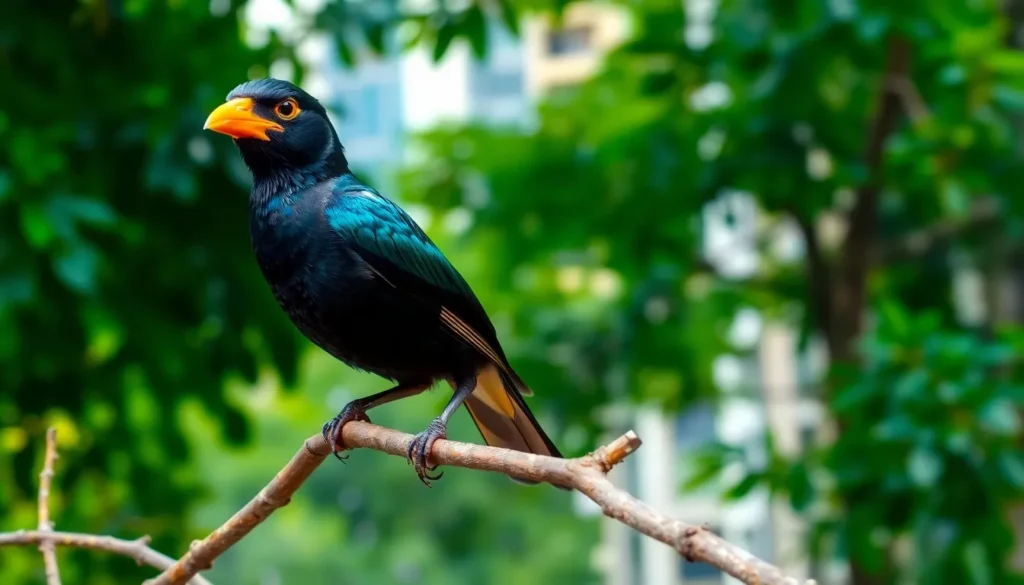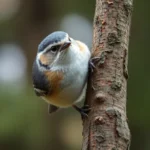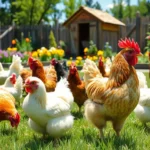Mynah birds have captivated bird enthusiasts worldwide with their remarkable intelligence and extraordinary vocal abilities. These charismatic creatures aren’t just beautiful to observe – they’re among nature’s most gifted mimics, capable of learning complex sounds and even human speech with startling clarity.
We’ve discovered that mynah birds possess cognitive abilities that rival those of parrots and crows, making them fascinating companions for experienced bird owners. Their playful personalities and social nature create unique bonds with their human families, while their stunning plumage and animated behaviors provide endless entertainment.
Whether you’re considering adding a mynah to your family or simply curious about these incredible birds, understanding their needs and characteristics is essential. From their dietary requirements to their housing needs, we’ll explore everything you need to know about these remarkable feathered friends and why they’ve earned their reputation as one of the most captivating pet bird species available today.
What Is a Mynah Bird?
Mynah birds represent a diverse group of starlings known for their exceptional mimicry abilities and striking appearance. These intelligent avians belong to the Sturnidae family and captivate bird enthusiasts worldwide with their remarkable vocal talents.
Physical Characteristics and Appearance
Mynah birds display distinctive features that make them easily recognizable among other bird species. Common mynah birds measure 9-10 inches in length and weigh between 4-5 ounces. Their glossy black plumage contrasts beautifully with bright yellow eye patches and orange-yellow bills.
White wing patches become visible during flight, creating a striking visual display. These birds possess strong, sturdy legs adapted for ground foraging and perching. Males and females appear nearly identical, making visual sex determination challenging for most observers.
Hill mynah birds, another popular species, showcase similar coloring but feature more pronounced yellow facial wattles. Their sleek bodies and alert posture reflect their active, intelligent nature.
Natural Habitat and Distribution
Mynah birds originate from South and Southeast Asia, where they thrive in diverse environments. Common mynah birds inhabit urban areas, agricultural lands, and open woodlands across India, Southeast Asia, and parts of the Middle East. These adaptable species flourish in cities like Mumbai, Bangkok, and Kuala Lumpur.
Hill mynah birds prefer tropical forests and wooded hills throughout India, Myanmar, Thailand, Malaysia, and Indonesia. They occupy elevations ranging from sea level to 6,000 feet, demonstrating remarkable environmental adaptability.
Human introduction has established mynah populations in Australia, New Zealand, South Africa, and various Pacific islands. Urban environments provide abundant food sources and nesting sites, allowing these birds to establish thriving colonies far from their native ranges.
| Species | Native Range | Introduced Locations | Preferred Elevation |
|---|---|---|---|
| Common Mynah | South/Southeast Asia | Australia, New Zealand, South Africa | Sea level – 3,000 feet |
| Hill Mynah | India to Indonesia | Limited introductions | Sea level – 6,000 feet |
| Bank Mynah | South Asia | Urban areas within range | Sea level – 2,000 feet |
Different Types of Mynah Birds
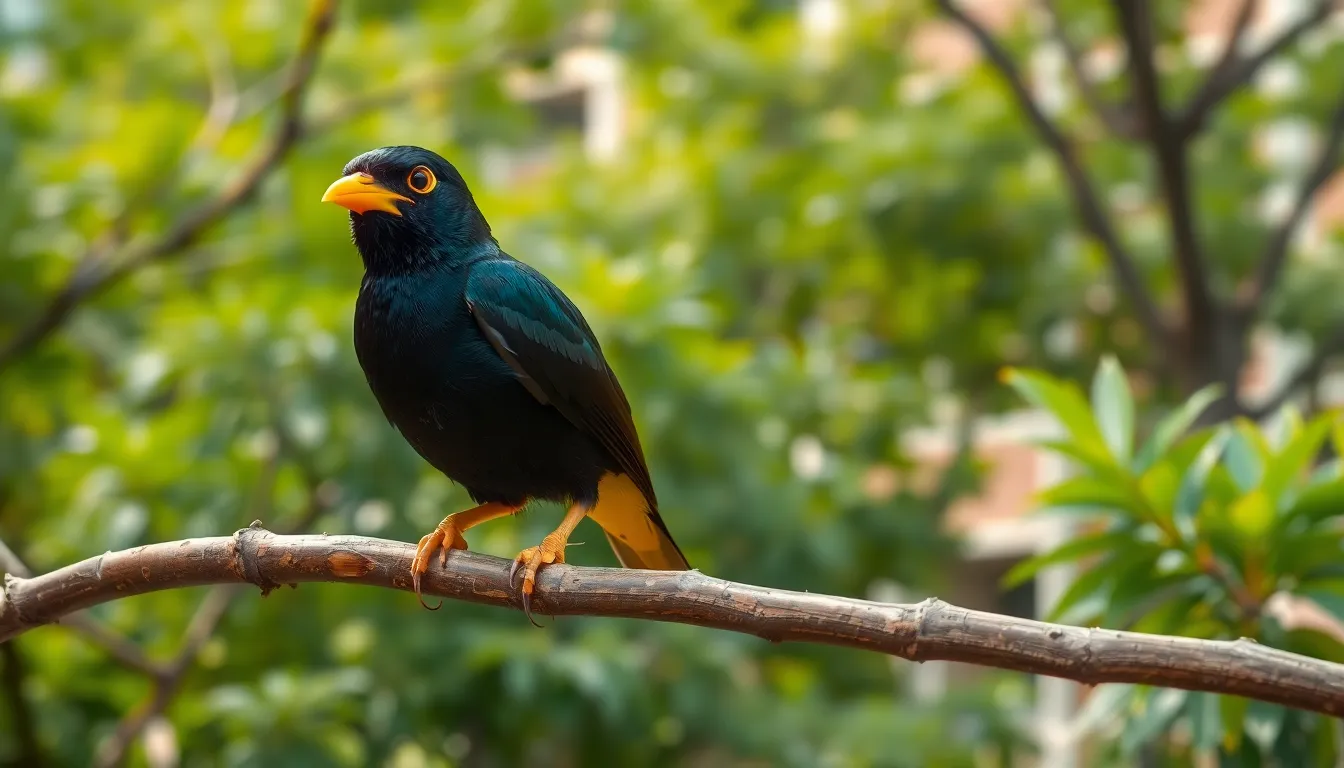
Mynah bird species display remarkable diversity in their physical characteristics and natural habitats. Each type offers unique traits that make them distinctive within the starling family.
Common Mynah
Common mynah birds represent the most widespread species in the Acridotheres tristis family. These adaptable creatures measure 9-10 inches in length and weigh approximately 4-5 ounces. Their glossy black plumage creates a striking contrast against bright yellow eye patches and vibrant orange-yellow bills.
We observe common mynahs thriving in urban environments and agricultural areas throughout South and Southeast Asia. Human settlements provide ideal foraging opportunities for these intelligent birds. Their diet consists of insects, fruits, berries and food scraps found near residential areas.
Breeding pairs of common mynahs construct nests in tree cavities, building crevices and artificial structures. Females lay 3-5 blue eggs during their reproductive season. These social birds form large roosts containing hundreds of individuals during non-breeding periods.
Hill Mynah
Hill mynah birds showcase superior vocal abilities compared to their common cousins. Gracula religiosa species reach lengths of 10-12 inches and display distinctive yellow facial wattles alongside their black feathers. Their larger size and prominent orange bills make them easily recognizable.
Tropical forests across Southeast Asia provide natural habitats for hill mynah populations. Dense canopy coverage offers protection while fruit-bearing trees supply their primary food source. We find these birds at elevations ranging from sea level to 4,900 feet.
Hill mynahs demonstrate exceptional mimicry skills that surpass most talking bird species. Their syrinx structure enables them to reproduce human speech with remarkable clarity. Pet owners prize these birds for their ability to learn complex phrases and sound effects.
Bali Mynah
Bali mynah birds stand apart with their pristine white plumage and striking blue facial skin. Leucopsar rothschildi represents one of the industry’s most endangered bird species with fewer than 100 individuals remaining in the wild. Their elegant appearance features black wingtips and tail edges that contrast beautifully against white feathers.
Endemic to Bali’s northwestern forests, these critically endangered birds face habitat destruction and illegal capture. Conservation programs work tirelessly to protect remaining wild populations through captive breeding initiatives. Zoos and wildlife facilities maintain genetic diversity through carefully managed breeding programs.
Adult Bali mynahs measure 9.5-10 inches in length and prefer dry forest environments with open understory areas. Their diet includes insects, fruits and small lizards found within their limited range. Successful conservation efforts have established several protected populations in specialized breeding facilities worldwide.
Mynah Bird Behavior and Intelligence
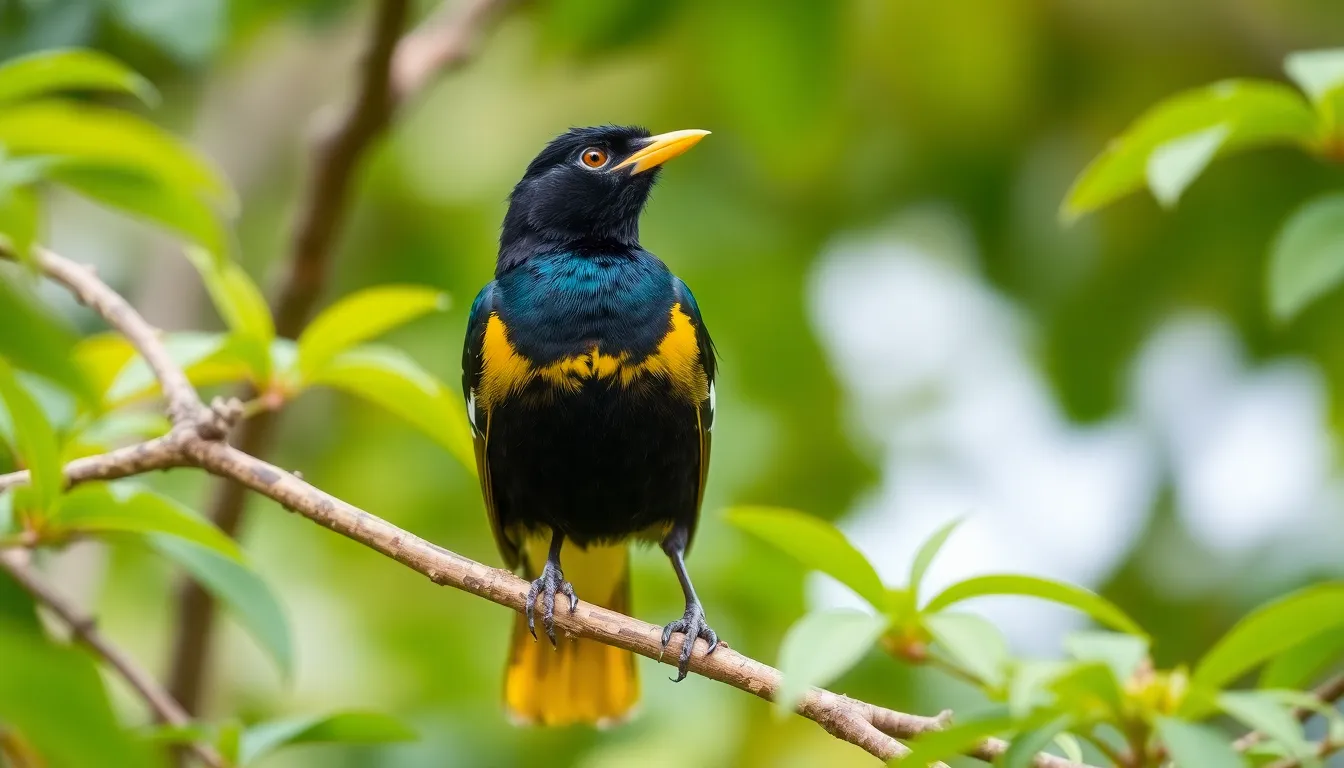
Mynah birds demonstrate remarkable cognitive abilities that rival those of parrots and corvids. These fascinating creatures exhibit complex behavioral patterns that make them exceptional companions and subjects of scientific study.
Vocal Abilities and Mimicry
Mynah birds possess extraordinary vocal learning capabilities that surpass most other bird species. Hill mynahs rank among the most skilled vocal mimics in the avian industry, capable of reproducing human speech with remarkable clarity and accuracy.
Their vocal repertoire extends far beyond simple mimicry. These birds learn environmental sounds including car alarms, telephone rings, and door chimes with precise reproduction. Wild mynahs incorporate over 30 distinct calls into their natural communication system.
The vocal learning process occurs through repetitive exposure and social interaction. Young mynahs begin mimicking sounds at approximately 3-4 months of age when their syrinx develops sufficient flexibility. Pet mynahs demonstrate faster learning rates in households with consistent vocal interaction.
Research indicates hill mynahs process vocal information through specialized brain regions similar to those found in songbirds. Their ability to modulate pitch, tone, and rhythm allows them to replicate complex speech patterns including different languages and accents.
Social Nature and Interaction
Mynah birds exhibit highly developed social behaviors that reflect their intelligence and adaptability. These gregarious creatures form complex hierarchical structures within their flocks and demonstrate sophisticated communication patterns.
Wild mynah populations engage in cooperative foraging behaviors where individuals share information about food sources through exact vocalizations. Flocks coordinate their movements using distinct alarm calls that indicate different types of threats including aerial predators and ground dangers.
Captive mynahs develop strong emotional bonds with their human caregivers through interactive play and vocal exchange. They recognize individual family members and adjust their behavior accordingly, often displaying different vocalizations for exact people.
Their social learning abilities manifest through observational skills that allow them to solve complex problems. Mynahs learn to open cage latches, manipulate objects, and navigate obstacles by watching and imitating both their owners and other birds.
Interactive enrichment activities stimulate their cognitive development and prevent behavioral issues. These activities include puzzle feeders, foraging toys, and structured training sessions that challenge their problem solving abilities while strengthening human bird relationships.
Keeping a Mynah Bird as a Pet

Mynah birds make fascinating companions for experienced bird owners who understand their complex needs. These intelligent creatures require specialized care and important daily interaction to thrive in captive environments.
Housing and Cage Requirements
Mynah bird housing demands a spacious environment that accommodates their active nature and size. We recommend cages measuring at least 32 inches wide by 18 inches deep by 21 inches high for a single bird. Flight cages work best since mynahs are naturally active and require room to move freely.
Bar spacing between 0.5 to 0.625 inches prevents escape while ensuring safety. Horizontal bars provide climbing opportunities that stimulate natural behaviors. Stainless steel or powder-coated cages resist rust and offer durability against mynah birds’ strong beaks.
Perch variety supports foot health through different diameters ranging from 0.5 to 2 inches. Natural wood branches like apple or willow provide texture variation. Rope perches offer flexibility while concrete perches help maintain nail length naturally.
Temperature control maintains comfort between 65-80°F with humidity levels around 50-60%. Draft-free locations away from kitchens protect birds from harmful fumes. Daily cleaning prevents bacterial growth in food and water dishes.
Diet and Nutrition Needs
Mynah bird nutrition centers on high-protein pelleted diets specifically formulated for softbills. These pellets contain 18-22% protein content that supports their carnivorous tendencies. Commercial mynah pellets from brands like ZuPreem or Kaytee provide balanced nutrition.
Fresh fruits comprise 20-30% of their daily intake including apples, grapes, berries and papaya. Vegetables like carrots, sweet potatoes and leafy greens supply essential vitamins. Protein sources such as cooked eggs, crickets and mealworms satisfy their insectivorous nature.
Foods to avoid include chocolate, avocado, caffeine and high-salt items that prove toxic to mynah birds. Iron-rich foods can cause iron storage disease, a common health issue in this species. Low-iron pellets reduce this risk significantly.
Water changes twice daily ensure freshness and prevent bacterial contamination. Shallow dishes accommodate their drinking preferences while preventing drowning accidents. Portion control prevents obesity since captive mynahs exercise less than wild counterparts.
Training and Socialization
Mynah bird training begins with trust-building exercises that establish positive human-bird relationships. Daily interaction sessions lasting 30-45 minutes develop social bonds essential for their psychological well-being. Consistent routines help reduce stress and create predictable environments.
Speech training leverages their natural mimicry abilities through repetitive vocal exercises. Morning sessions when birds are most alert produce optimal learning results. Clear pronunciation and consistent phrases accelerate vocabulary development in young mynahs under two years old.
Socialization with multiple family members prevents over-bonding to single individuals. Supervised interactions with other household pets require careful monitoring due to mynah birds’ territorial instincts. Early exposure to various sounds, people and situations creates well-adjusted companions.
Positive reinforcement using favorite treats rewards desired behaviors effectively. Target training teaches mynahs to touch exact objects on command, providing mental stimulation. Flight recall training in secure indoor spaces maintains their natural flying abilities while ensuring safety.
Mynah Bird Care and Health
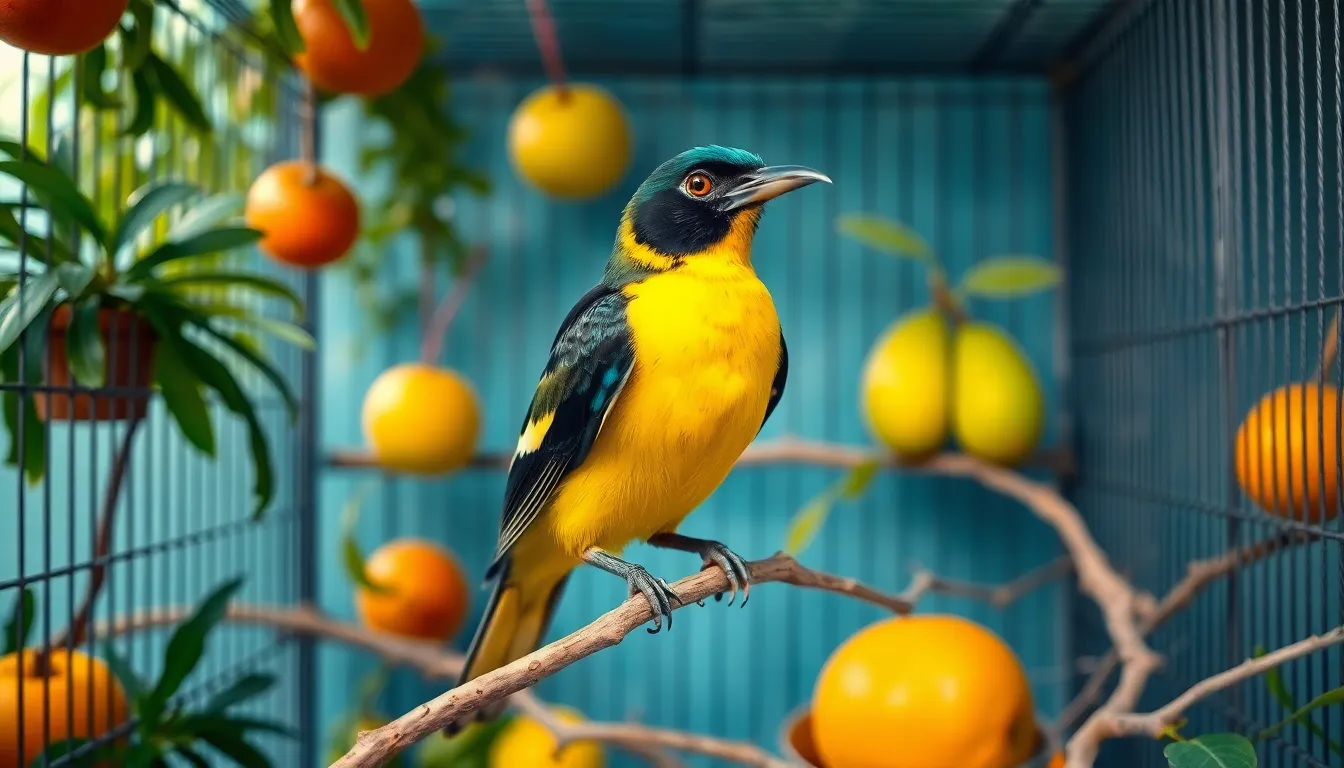
Mynah birds require proactive health management and regular veterinary attention to maintain their vibrant personalities and vocal abilities. Understanding their exact health challenges enables us to provide optimal care for these intelligent companions.
Common Health Issues
Mynah birds face several distinct health challenges that owners must recognize early. Iron storage disease ranks among the most serious conditions affecting mynahs, as their digestive systems absorb iron more efficiently than other bird species. This metabolic disorder causes iron accumulation in organs like the liver and heart, potentially leading to organ failure without proper dietary management.
Respiratory infections occur frequently in mynah birds due to their sensitive airways and active nature. Bacterial pneumonia, aspergillosis, and other fungal infections manifest through symptoms including labored breathing, tail bobbing, and reduced vocalization. Environmental factors such as dusty conditions, poor ventilation, or sudden temperature changes often trigger these respiratory issues.
Feather plucking represents another important concern among captive mynahs, typically stemming from stress, boredom, or inadequate social interaction. Birds experiencing this behavioral condition repeatedly pull out their own feathers, creating bald patches and potential skin infections. Addressing underlying causes requires environmental enrichment and consistent daily engagement.
Gastrointestinal problems frequently affect mynah birds consuming inappropriate diets or contaminated foods. Diarrhea, regurgitation, and crop stasis indicate digestive disturbances that require immediate attention. Bacterial infections from spoiled fruits or vegetables compound these issues, emphasizing the importance of fresh food provision.
Parasitic infections including giardia, roundworms, and external mites pose ongoing threats to mynah health. Internal parasites cause weight loss, poor feather quality, and digestive irregularities, while external parasites create skin irritation and excessive scratching behaviors.
Veterinary Care and Maintenance
Establishing relationships with avian veterinarians specializing in mynah care provides essential health support throughout their 12-15 year lifespan. Annual wellness examinations enable early detection of iron storage disease through blood testing and liver function assessment. These comprehensive checkups include physical evaluations, weight monitoring, and preventive care recommendations.
Routine blood panels monitor iron levels, complete blood counts, and organ function markers exact to mynah physiology. Veterinarians typically recommend iron level testing every 6 months for adult birds and quarterly monitoring for birds showing early symptoms of iron storage disease.
Preventive care protocols include regular fecal examinations for parasitic infections and bacterial cultures when digestive issues arise. Vaccination schedules vary based on geographic location and exposure risks, with some regions requiring exact immunizations for common viral diseases.
Emergency care recognition becomes critical for mynah owners, as birds often hide illness symptoms until conditions become severe. Changes in vocalization patterns, appetite reduction, breathing difficulties, or behavioral alterations warrant immediate veterinary consultation.
Quarantine procedures protect existing bird populations when introducing new mynahs to multi-bird households. A minimum 30-day isolation period allows comprehensive health screening and prevents disease transmission between birds.
Home health monitoring involves daily observation of eating habits, droppings consistency, activity levels, and vocal behaviors. Weight tracking using gram scales provides objective health indicators, with sudden weight loss exceeding 10% requiring emergency veterinary attention.
Environmental modifications support ongoing health maintenance through proper cage cleaning schedules, air filtration systems, and humidity control. Regular disinfection of food dishes, water containers, and perch surfaces prevents bacterial growth and reduces infection risks.
Pros and Cons of Mynah Bird Ownership
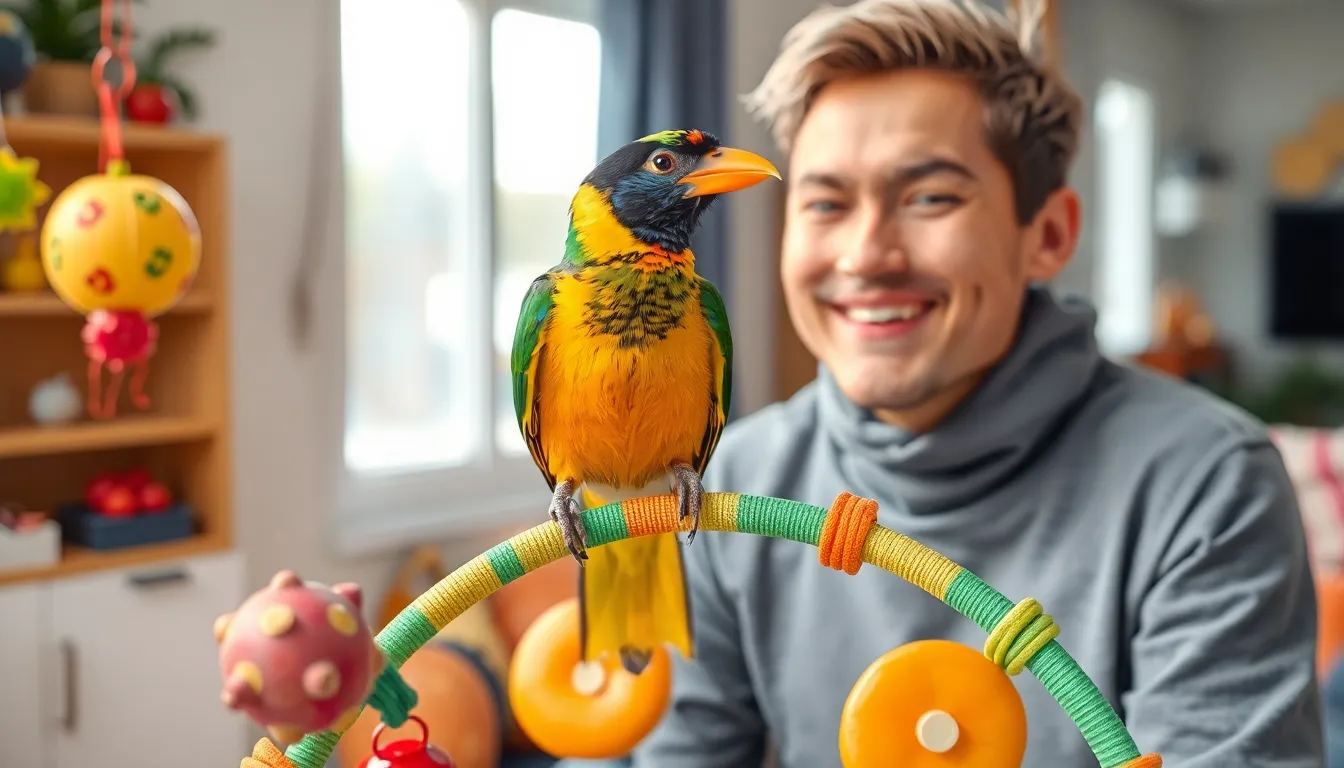
Owning a mynah bird brings unique rewards and important challenges that every prospective owner must carefully evaluate.
Advantages of Mynah Bird Companionship
Exceptional Intelligence and Trainability
Mynah birds demonstrate cognitive abilities that surpass many other pet bird species. These remarkable creatures learn complex tricks, solve puzzles, and respond to their names with consistent accuracy. Hill mynahs particularly excel at mimicking human speech patterns, often reproducing conversations with startling clarity and emotional inflection.
Strong Social Bonds
Captive mynahs form deep emotional connections with their primary caregivers through daily interaction and consistent care routines. These birds recognize individual family members, show excitement upon their return, and actively seek attention through vocalizations and physical proximity. Their affectionate nature creates rewarding companionship experiences that can span 15-25 years.
Entertainment Value
Interactive mynah birds provide endless amusement through their playful behaviors and vocal performances. Common mynahs learn household sounds like doorbell chimes, telephone rings, and even exact family member voices. Their natural curiosity drives them to explore new toys, investigate novel objects, and engage in problem-solving activities that showcase their mental agility.
Challenges of Mynah Bird Care
Intensive Daily Requirements
Mynah birds demand 3-4 hours of direct interaction each day to maintain their psychological well-being. These social creatures develop behavioral problems like feather plucking, excessive screaming, and aggression when left alone for extended periods. Working professionals often struggle to meet these substantial time commitments consistently.
Specialized Dietary Needs
Proper mynah nutrition requires expensive pelleted diets specifically formulated for softbill species, costing $30-50 monthly for quality products. Fresh fruit and vegetable supplements must be prepared daily, with toxic foods like avocado, chocolate, and caffeine requiring constant vigilance. Iron storage disease affects many captive mynahs fed inappropriate diets, necessitating regular veterinary monitoring.
Important Financial Investment
Initial setup costs range from $800-1,500 for appropriate housing, toys, and essential supplies. Avian veterinary care averages $200-400 annually for routine checkups, with emergency treatments potentially reaching $1,000-3,000. Quality mynah birds from reputable breeders cost $500-2,000 depending on species and lineage.
Noise and Space Considerations
Mynah vocalizations reach 85-95 decibels during peak activity periods, creating potential conflicts with neighbors in apartment settings. These active birds require flight cages measuring minimum 4×3×6 feet, occupying considerable indoor space. Their natural behaviors include food scattering and occasional aggressive territorial displays that some households find disruptive.
Complex Health Management
Respiratory infections, parasitic infestations, and stress-related disorders commonly affect captive mynahs without proper environmental controls. Finding qualified avian veterinarians proves challenging in many geographic regions, limiting access to specialized care when health issues arise. Regular blood testing for iron levels and routine fecal examinations add ongoing medical expenses that many owners don’t anticipate.
Conclusion
We’ve explored the intriguing area of mynah birds and their remarkable abilities that make them such captivating companions. These intelligent creatures offer unique rewards for dedicated owners who understand their complex needs and can provide the specialized care they require.
Owning a mynah bird isn’t a decision to take lightly. The financial commitment specialized diet housing requirements and need for consistent social interaction demand serious consideration before bringing one home.
For those ready to embrace the challenge mynah birds can become extraordinary lifelong companions. Their intelligence vocal abilities and strong social bonds create relationships that are truly rewarding for committed bird enthusiasts who appreciate their remarkable nature.
Frequently Asked Questions
What makes mynah birds exceptional pets compared to other birds?
Mynah birds are exceptional pets due to their remarkable intelligence and vocal abilities. They can learn complex sounds and human speech with clarity that rivals parrots. Their cognitive skills are comparable to crows and parrots, making them highly interactive companions. They also form strong emotional bonds with their owners and exhibit playful, social behavior that makes them engaging pets.
What do mynah birds look like and how big do they get?
Common mynah birds measure 9-10 inches in length and have glossy black plumage with distinctive bright yellow eye patches and orange-yellow bills. Hill mynahs are slightly larger and known for their superior vocal abilities. The rare Bali mynah stands out with striking white plumage. All species have sturdy builds and are part of the starling family.
Where do mynah birds naturally live?
Mynah birds are native to South and Southeast Asia. Common mynahs thrive in urban areas and agricultural lands, showing remarkable adaptability to human environments. Hill mynahs prefer tropical forests and dense woodland areas. Due to human introduction, some mynah populations have established themselves in various regions outside their native ranges, including parts of Australia and other countries.
What are the different types of mynah birds?
The three main types are Common Mynah, Hill Mynah, and Bali Mynah. Common mynahs are the most widespread and urban-adapted species. Hill mynahs are prized for their exceptional vocal mimicry abilities and live in tropical forests. Bali mynahs are critically endangered with distinctive white plumage and are the focus of conservation breeding programs.
How intelligent are mynah birds?
Mynah birds possess remarkable cognitive abilities that rival parrots and corvids. They demonstrate problem-solving skills through observational learning and can learn complex vocal patterns. Hill mynahs particularly excel at reproducing human speech and environmental sounds with exceptional clarity. Their intelligence is enhanced through social interaction and mental stimulation, making them highly trainable and interactive companions.
What do mynah birds eat and what are their dietary requirements?
Mynah birds require high-protein pelleted diets as their foundation, supplemented with fresh fruits and vegetables. They naturally eat insects, fruits, and small invertebrates. In captivity, avoid toxic foods like chocolate, avocado, and caffeine. Their diet should be varied and nutritious, with particular attention to preventing iron storage disease through appropriate food choices and specialized mynah pellets.
What kind of housing do mynah birds need?
Mynah birds need spacious cages with appropriate bar spacing to accommodate their active nature. The cage should include variety in perch types and sizes to support foot health. They require daily out-of-cage time for exercise and social interaction. The housing setup should include enrichment activities and toys to stimulate their high intelligence and prevent boredom.
Are mynah birds good talkers?
Yes, mynah birds are exceptional talkers, particularly hill mynahs. They can reproduce human speech and environmental sounds with remarkable clarity and accuracy. Their vocal learning process is enhanced through social interaction and consistent exposure to speech. Unlike some parrots, mynahs often speak with less mechanical repetition and can develop impressive vocabularies when properly trained and socialized.
What health problems do mynah birds commonly face?
Common health issues include iron storage disease, respiratory infections, feather plucking, gastrointestinal problems, and parasitic infections. Iron storage disease is particularly serious and requires specialized low-iron diets. Regular veterinary checkups with avian specialists are essential for preventive care, including blood tests and fecal examinations to monitor their health status.
Are mynah birds suitable for beginner bird owners?
Mynah birds require specialized care and are better suited for experienced bird owners. They need intensive daily interaction, specialized diets, significant financial investment, and complex health management. While rewarding companions, they present challenges including noise levels, space requirements, and the need for consistent socialization. Prospective owners should carefully consider these demanding care requirements before committing.

